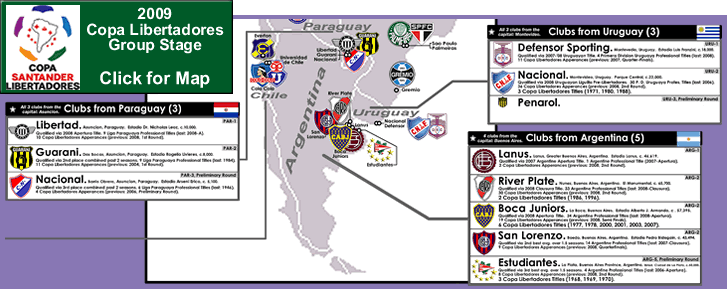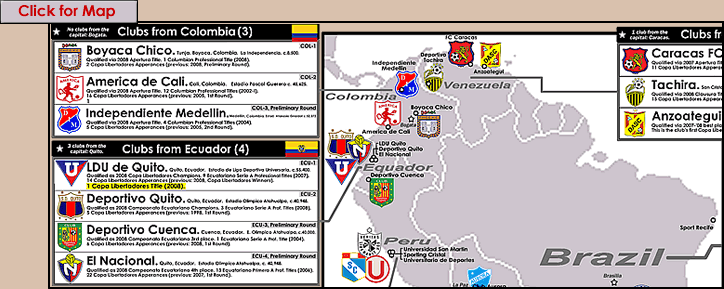
2009 Copa Libertadores Group Stage. {Wikipedia’s page on 2009 Copa Libertadores, click here}.
Game highlights from 12th Februaruy (via 101 Great Goals site) …
Nacional de Montevideo (Uru.) 2- 1 Universidad San Martin de Porres (Peru). {click here [Check out the overflowing crowd in the nice compact stadiumi n the Uruguayan capital; free kick goal by Nacional's Federico Dominguez at 0:01; stunning full-stride volley at 2:00, by San Martin's Martin Arzuaga; injury-time winner by Nicolas Lodeiro at 2:35.]
Universitario de Sucre (Bol.) 1-1 Deportivo Quito (Ecu.) {click here [In the cavernous 2/3-empty bowl up in the high altitude of Bolivia, goals at 0:10, by the home side's Marcelo Gomes; and by the visitor's Mauricio Donoso at 0:30.]
River Plate (Arg.) 1-0 Nacional (Par.). {click here [With River's giant El Monumental filled to a respectable crowd level, the winner came in injury time, at 2:44 on the video, by River Plate's talismanic, 5 ft.-2 in. striker Diego Buonanotte .]
The 32 Clubs, by country…
Written by Sam Kelly. [Sam at Hasta El Gol Siempre, {Click here}; at ESPN Soccernet/ Sam Kelly archive, {Click here}.]
Argentina. Boca Juniors. Founded 1905. The second most successful side domestically in Argentina, and the most popularly supported. They’re also the most successful side in this year’s Copa, a win will draw them level (on seven titles) with their fellow Argentines Independiente.
Estudiantes. [see previous Copa Libertadores post, from 27th January, 2009...Click here].
Lanus. Founded 1915. [Lanus is a southern suburb of Buenos Aires.] One of the revelations of recent years in Argentina, winning their first title in the 2007 Apertura to qualify for this year’s Copa, they play some of the most attractive football in the country. They won the 1996 CONMEBOL (a forerunner of the Copa Sudamericana).
River Plate. Founded 1901. Top of CONMEBOL’s recently revised all-time Copa Libertadores standings (which award points-per-game won), largely thanks to have participated in the Copa more times than any other Argentine side. They’ve also won more domestic titles than any one else, but have only won the Copa twice, and finished bottom of the 2008 Apertura.
San Lorenzo de Almagro. Founded 1908. The only one of Argentina’s ‘Big Five’ never to have won the Copa, San Lorenzo’s most recent domestic title came in the 2007 Clausura, but they went to a three-way playoff with Boca and minnows Tigre to decide last year’s Apertura. Have 10 professional titles in Argentina, and will be desperate to break their Copa duck.
Bolivia. Club Aurora. Founded 1935. The current champions of Bolivia after claiming their first professional title with last year’s Clausura, but also won a semi-pro title in 1963. Their one previous Copa appearance was in 1964, with a first round exit.
Club Universitario. Founded 1962. Last year’s Torneo Apertura was their first domestic title, after winning promotion to the top flight in 2005. They’re making their Copa Libertadores debut this year, but appeared in the Copa Sudamericana in 2006, with a first round exit.
Brazil. Cruziero. Founded 1921. The club that launched Ronaldo’s career, two-times Copa Libertadores winners [1976 and '77] and once Brazillian champions (in 2003), the Belo Horizonte team finished third in last year’s Brasileiro.
Gremio. Founded 1903 [in the southern city of Porto Allegre]. Have won two Copas [1983, 1995] and two national titles, enjoying their most successful era under just-sacked Chelsea manager Luis Felipe Scolari, and have produced players like Ronaldinho and Manchester United’s Anderson through their academy. Lost the 2007 Copa final by a landslide against a Juan Roman Riquelme-inspired Boca Juniors.
Palmeiras. {see previous Copa Libertadores post, here}. [1 Copa Libertadores title, in 1999.]
Sao Paulo. Founded 1930. One of Brazil’s giants, their 2008 league win made them the first side to win the Brazilian title three times running. They’ve also won three Copa Libertadores titles and have been crowned world champions [FIFA Club World Cup] thrice.
Sport Recife. Founded 1905. Eleventh in last year’s first division, they qualified for the Copa by virtue of winning the Copa do Brasil, but have made only one previous appearance, in 1988, when they were eliminated in the group stage.
Chile. Colo Colo. Founded 1925. One of eight founder clubs of the Chilean first division in 1933, they’re the only club to have never been relegated, and with 28 titles (including five in the last 6 championships) are the most successful trophy-wise, too. Having won the 1991 Copa Libertadores, they’re also the only Chilean side to have been crowned South American champions.
Everton (de Vina del Mar). Founded 1909 by an Englishman, David Foxley, and named after a rather more famous club in his home country. The second most successful of the clubs outside the Chilean capital Santiago, with four national titles, most recently in June last year when they claimed the Apertura title. Previously knocked out in the first round of the 1977 Copa, their only other appearance.
Universidad de Chile. {see previous post, here}.
Colombia. América de Cali. Founded 1918 or 1927, depending who you ask. The joint most successful club (along with Millonarios of Bogotá) in the history of the Colombian league, América have been in financial turmoil for some time and frequently have transfer negotiations affected by their controversial inclusion on the ‘Clinton List’ [see this]. Reached three straight Copa finals in the mid-1980s, and were there again in 1996, but have never managed to get their hands on the trophy.
Boyacá Chicó. Founded 2002 [in the capital, Bogotá, but in 2004, moved to the city of Tunja in the province of Boyacá] . One of several relatively new clubs in Colombia to have enjoyed success early on in their history, after beating the domestic giants of América de Cali in the final of last year’s Torneo Apertura. They went out in the qualifying round of last year’s Copa, so will be hoping to prove they can do the business in this year’s group stage.
Independiente Medellin. {see this}.
Ecuador. Deportivo Cuenca. {see this}.
Deportivo Quito. Founded 1940 as Sociedad Deportiva Argentina, and changed their name to the current Sociedad Deportivo Quito in 1955. Spoiled their cross-city rivals’ post-Copa celebrations somewhat by beating Liga to the Ecuadorian title last year to claim their third national title. This is their sixth Copa, and they’ve only made it beyond he first round once, in 1989, when they reached the second round.
LDU de Quito. Founded 1930. The defending Copa Libertadores champions after shocking all comers on their way to last year’s final before beating fellow first-time-finalists Fluminese of Brazil on penalties to become the first Equadorian side to win the Copa. Have recently changed managers after Edgardo Bauza’s resignation, but whilst few expect lightning to strike twice, they’ll at least want to show last year wasn’t a fluke.
Mexico. CD Guadalajara (“Chivas”). Founded 1906. Mexico’s most widely-supported club, in no small part by virtue of their policy of fielding only Mexican players. They’ve come as close as any to winning the Copa Libertadores, having reached back-to-back semi-finals in 2005 and 2006, but their most notable trophies are their [record] 11 Mexican national titles, most recently the 2006 Apertura. ["Chivas" ('Goats') nickname was applied as an insult by a journalist in 1948, picked up by opposing fans, and eventually adopted by the club's supporters themselves with pride {thanks to Albion Road, here, site for that}.]
San Luis FC. Founded 1957. Avoided relegation by the skins of their teeth at the end of the 2006 Apertura, but are making their Copa debut this term by virtue of an impressive performance in the regular season of last year’s Apertura.
Paraguay. Guarani. Founded 1903 [named for the indigenous people of the region, the Guarani; uniforms with black and yellow vertical stripes are in reference to Uruguayan giants Penarol]. Have won nine championships, most recently in 1984, and were runners-up to Libertad last year. Reached the Copa semi-final in in 1966, but haven’t been beyond the first round in two attempts this century.
Libertad. Founded 1905. With 14 titles, they’re the third most decorated club in Paraguayan football, and have nine Copa participations to their name, with semi-final appearances in 1977 and 2006, and a quarter-final in 2007.
Nacional. {see this}.
Peru. Universidad San Martin de Porres. Founded 2004, and have already won two titles- in 2007 and 2008- after beginning life in the second division, by ‘buying’ their first division place from Sport Coopsol, and improving rapidly. The first Peruvian club to be founded as a Joint Stock Company, they beat River Plate of Argentina 2-0 in their first ever Libertadores match last year, but were eliminated at the end of the group stage.
Univeritario. Founded 1962 [are the most popular club in Peru]. Have never been relegated from Peru’s top flight, and have won more more Peruvian tiles (24) than any other club, and were the first Peruvian club to reach the final of the Copa, in 1972, but have won no national championships since 2000.
Venezuela. Caracas FC. Founded 1967. Nine national titles make them the most-crowned team in Venezuela, and they became the first Venezuelan side to ever win in Argentina when beating River Plate two years ago. Finished second last season, and have never been beyond the round of sixteen [2nd round], which they reached in 2007.
Táchira. Founded 1974. They’ve won six first division titles, most recently last season, and reached the quarter-finals of the 2004 Copa before losing a match. [From San Cristóbal, Tachira state, in the far west of Venezuela near the Columbian border.]
Much thanks to Sam Kelly for the fine write-up. Check out his great Hasta El Gol Siempre site, the place to go for English-language news and insight into the Argentinian game: http://hastaelgolsiempre.com/.

